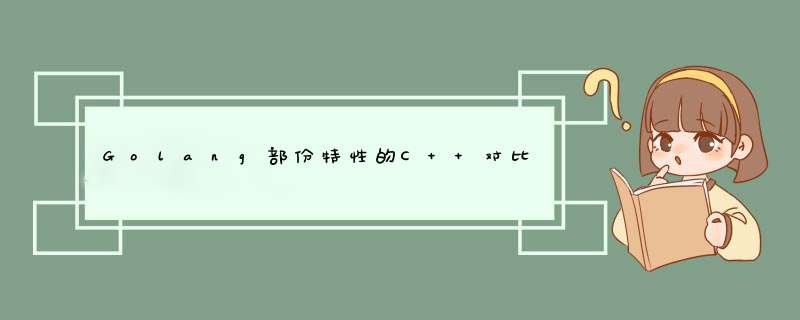
今天看到一篇文章<<C++ 逐渐 Python 化>>, 我个人是认为这个说法是不成立的,但这里面的一些特性对比引起了我的兴趣。
我想尝试下,Go语言所带的一些东西,在C++11中是如何做的,应当很有意思。所以刷刷刷,就有了下面的东西。
目录:
字符串字面值
变量初始化
lambda
值顺序递增
多值赋值及函数返回多值
map查找
可变参数
回调函数
泛型
数组和切片
这个东西在两种语言中都有比较好的解决方式.Go语言用" ` "符号,C++使用R(" )"这种方式。可以省掉不少转义符的输入。
Golang
[cpp] view plain copy path:=`c:\a\b\c\GG再也不用烦转义符了` mulln:=`"(C++/Golang aa'aaa\Cplusplus/gogogo author"xiongchuanliang ` fmt.Println(path) fmt.Println(mulln) C++
copy stringpath=R"(c:\a\b\c\GG再也不用烦转义符了)"; cout<<"单行:"<<path.c_str()<<endl; stringmuln=R"(C++/Golang )"; cout<<"多行:"<<muln.c_str()<<endl;
变量初始化
现在开发语言的初始化都差不多,都能很方便的定义时初始化,循环也是如下面中的C++ for循环和Go语言中的"for : rang"
形式基本一样。 另外C++的auto,Go语言中的":=",都能省代码的好东西。不过要多提一句,Go语言支持多重赋值,并且变量都
是默认就已初始化好。同时,Go语言也支持指针,但它的指针要安全得多。
Golang
copy varkint fmt.Println(k) mArr:=[]int{1,2,3} varmMap=map[string]int{"a":1,"b":2} fmt.Printf("array:%v\nmap:%v\n",mArr,mMap) i:=10 pi:=&i//*i ppi:=&pi//**int fmt.Println(i,*pi,**ppi) //结果: 0 array:[123] map:map[a:1b:2] 101010
C++
copy intmArr[]={1,3}; automList=vector<int>{1,3,4}; automMap=map<int,string>{{1,"aa"},{2,"bb"}}; cout<<"vector:"; for(constint&x:mList) cout<<x<<""; cout<<endl; cout<<"map:"; constauto&mp:mMap) cout<<mp.first<<""<<(mp.second).c_str(); cout<<endl;
lambda
lambda这东西在C++11中可是重点推荐的特性,非常的强大。Go语言自然也有,但对于匿名函数中函数外部变量的处理
并没有C++那么多种。 像C++分了四类:
[a,&b] a变量以值的方式呗捕获,b以引用的方式被捕获。
[this] 以值的方式捕获 this 指针。
[&] 以引用的方式捕获所有的外部自动变量。
[=] 以值的方式捕获所有的外部自动变量。
[] 不捕获外部的任何变量。
而Go语言默认就相当于"[=]",即,捕获可见范围内所有的外部变量。
Golang
copy mArr:=[]fun:=func(i,vint){ fmt.Printf("idx:%dvalue:%d\n",i,v) } foridx,val:=rangemArr{ fun(idx,val) }
C++
copy intarr[]={1,248); line-height:18px; margin:0px!important; padding:0px 3px 0px 10px!important; list-style-position:outside!important"> for_each(begin(arr),end(arr),[](intn){cout<<n<<endl;}); autofunc=[](intn){cout<<n<<endl;}; for_each(begin(arr),func);
值顺序递增(iota)
iota这个小东西很有特点,两种语言都支持且都是让数据顺序递增,从功能上看C++的iota似乎更强大灵活些。 但有意思的是,
似乎在Go语言中,iota的使用频率要高得多,被大量的用于像const定义之类的地方,有意思。
Golang
copy const( Red=iota Green Blue ) fmt.Println("Red:",Red,"Gree:",Green,"Blue:",Blue);C++
copy intd[5]={0}; std::iota(d,d+5,10); cout<<"iota_demo():old:d[5]={0}"<<endl; cout<<"iota_demo():iota:d[5]={"; foreach(intvarind) { cout<<var<<""; } cout<<"}"<<endl; chare[5]={'a'}; charf[5]={0}; copy_n(e,5,f); cout<<"iota_demo():old:e[5]={'a'}"<<endl; cout<<"iota_demo():iota:e[5]"<<endl; std::iota(e,e+5,'e'); for(size_ti=0;i<5;i++) { cout<<"iota="<<e[i]<<endl; 值顺序递增 iota_demo():old:d[5]={0} iota_demo():iota:d[5]={1011121314} iota_demo():old:e[5]={'a'} iota_demo():iota:e[5] iota=e iota=f iota=g iota=h iota=i 值顺序递增end.
多值赋值及函数返回多值
这个功能在Go语言中相当方便,C++中则需要使用tuple和 tIE等才能实现,有点麻烦,但效果是一样的。
Golang
copy functuple_demo()(a,b:=1,2 fmt.Println("a:",a,"b:",b); c,d:=b,a fmt.Println("c:",c,"d:",d); return168,"函数返回的字符串" } C++ copy tuple<tuple<ret=make_tuple(168,"函数返回的字符串"); cout<<"tuple_demo():"<<get<0>(ret)<<""<<(get<1>(ret)).c_str()<<endl; autotriple=make_tuple(5,6,7); cout<<"tuple_demo():"<<get<0>(triple)<<""<<get<1>(triple)<<""<<get<2>(triple)<<endl; intti; stringts; tie(ti,ts)=make_tuple(10,"xcl--将数字和字符赋值给两个变量"); cout<<"tuple_demo():"<<ti<<""<<ts.c_str()<<endl; returnret; //调用: intti; stringts; tie(ti,ts)=tuple_demo(); cout<<"main()<-tuple_demo():"<<ti<<""<<ts.c_str()<<endl; //结果: 多值赋值及函数返回多值 tuple_demo():168函数返回的字符串 tuple_demo():567 tuple_demo():10xcl--将数字和字符赋值给两个变量 main()<-tuple_demo():168函数返回的字符串 多值赋值及函数返回多值end.
map查找
Go语言中map的查找特别方便. 要找个值,直接map[key]就出来了。C++也可以直接用find(key)的方式,但Go语言直接有个
found的变量,能告知是否有找到,这个要比C++去比end(),要直观些,也可以少打些字。
Golang
copy varmMap=map[string]"b":2,"c":3} val,found:=mMap["b"] iffound{ fmt.Println("found:",val); }else{ fmt.Println("notfound"); copy typedefmap<string,int>map_str_int; tuple<string,bool>mapfind_demo(map_str_intmyMap,stringkey){ map_str_int::iteratorpos; pos=myMap.find(key); if(pos==myMap.end()){ returnmake_tuple("",false); returnmake_tuple(pos->first,pos->second,153); background-color:inherit; font-weight:bold">true); //调用: automyMap=map_str_int{{"aa",1},{"bb",2},{"cc",3}}; stringmpKey; intmpValue; boolmpFound=false; tie(mpKey,mpValue,mpFound)=mapfind_demo(myMap,"bb"); if(mpFound){ cout<<"mapfind_demo:found"<<endl; cout<<"mapfind_demo:notfound"<<endl; } 可变参数可变参数是指函数的最后一个参数可以接受任意个参数,我在用Go语言实现的args_demo()例子中,用了效果一样的两种不同
调用方法来展示Go语言对这个下的功夫。然后可以再看看通过C++模板实现的,一个比较有代表性的Print函数来感受感受C++
对这个可变参数的处理方式。
Golang
copy funcargs_demo(firstint){ fmt.Println("ars_demofirst:",first) for_,i:=rangeargs{ fmt.Println("args:",i) //调用 args_demo(5,7,8); int{5,8} args_demo(mArr[0],mArr[1:]...); fmt.Println("fmtPrintln():",1,2.0,"C++11","Golang"); 执行结果 变量fmtPrintln():12C++11Golang ars_demofirst:5 args:6 args:7 args:8 args:8
copy template<typenameT>voidfmtPrintln(Tvalue){ cout<<value<<endl; typenameT,153); background-color:inherit; font-weight:bold">typename...Args> voidfmtPrintln(Thead,Args...args) cout<<head<<""; fmtPrintln(args...); fmtPrintln("fmtPrintln():",0); background-color:inherit">//执行结果: 变长参数 fmtPrintln():12C++11Golang 变长参数end.
回调函数
对比看看两种语言函数的回调处理,实现方法没啥差异。
copy typefuncTypefunc(string) funcprintFunc(strstring){ fmt.Println("callFunc()->printFunc():",str) funccallFunc(argstring,ffuncType){ f(arg) callFunc("回调就是你调我,我调它,大家一起玩。",printFunc) C++
C++泛型就不用多说了,都知道有多强大。Go语言要加入这个不知道是啥时候的事,不过通过简单的反射,还
是可以实现类似的功能,但代码有点长。
Golang
copy @H_746_404@ funccompare(v1,v2interface{})(v1.(type){ caseint: ifv1.(int)<v2.(return-1,nil elseint)==v2.(return0,153); background-color:inherit; font-weight:bold">caseint8: ifv1.(int8)<v2.(int8){ ifv1.(int8)==v2.(int8){ caseint32: ifv1.(int32)<v2.(int32){ ifv1.(int32)==v2.(int32){ //省略...... default: return-2,errors.New("未能处理的数据类型.") return1,248); line-height:18px; margin:0px!important; padding:0px 3px 0px 10px!important; list-style-position:outside!important"> v1:=13 v2:=53 ret,err:=compare(v1,v2) iferr!=nil{ fmt.Println(err) return switchret{ case-1: fmt.Println("v1<v2") case0: fmt.Println("v1==v2") case1: fmt.Println("v1>v2") default: fmt.Println("defualt") }
C++
copy typenameT>intcompare(constTv1,153); background-color:inherit; font-weight:bold">constTv2){ if(v1<v2){ cout<<"compare():v1<v2"<<endl; return-1; if(v1==v2){ cout<<"compare():v1==v2"<<endl; return0; else{ cout<<"compare():v1>v2"<<endl; return1; inti1=5,i2=7; doubled1=52.5,d2=10.7; compare(i1,i2); compare(d1,d2);
数组/切片Go语言做得非常灵活,不一一举例,这里主要可以看看C++的。我用copy_n,copy_if 模拟二下简单的切片功能。
Golang
copy a:=[5]b:=a[:3] c:=a[1:2] fmt.Println(a) fmt.Println(b) fmt.Println(c) //运行结果:<span></span> [12345] [123] [2] copy inta[5]={1,5}; intb[3]={0}; intc[2]={0}; cout<<"a[5]={1,5}"<<endl; cout<<"array[:end_pos]:b=array[:3]"<<endl; //array[:end_pos] copy_n(a,b); intvarinb) cout<<""<<var; cout<<"a[5]={1,5}"<<endl; cout<<"array[begin_pos:end_pos]:c=array[1,2]"<<endl; //array[begin_pos:end_pos] intbegin_pos=1; intsubLen=sizeof(c)/sizeof(c[0]); intend_pos=begin_pos+subLen; copy_if(a+begin_pos,a+end_pos,87); background-color:inherit; font-weight:bold">intv){returntrue;}); intvarinc) cout<<""<<var; cout<<endl; //运行结果: 数组和切片(sclie) a[5]={1,5} array[:end_pos]:b=array[:3] 123 a[5]={1,5} array[begin_pos:end_pos]:c=array[1,2] 23 数组和切片(sclie)end.
很粗浅的分别实现下这几个点,体会是C++很强大,Golang更纯粹,少即是多。
Go语言和C++完整测试源码我放在此:点击下载
可以自行下载编译。
总结以上是内存溢出为你收集整理的Golang部份特性的C++对比实现全部内容,希望文章能够帮你解决Golang部份特性的C++对比实现所遇到的程序开发问题。
如果觉得内存溢出网站内容还不错,欢迎将内存溢出网站推荐给程序员好友。
欢迎分享,转载请注明来源:内存溢出

 微信扫一扫
微信扫一扫
 支付宝扫一扫
支付宝扫一扫
评论列表(0条)